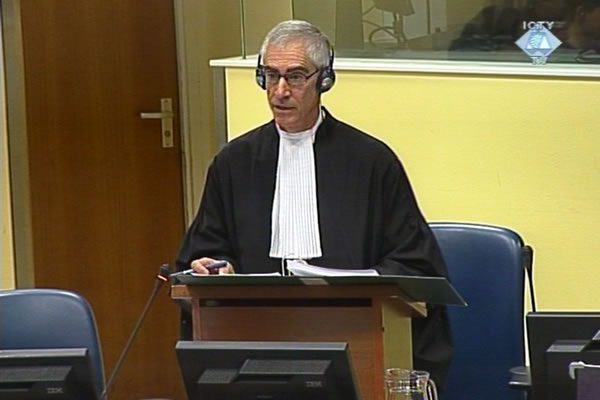Home
KARADZIC AND SREBRENICA GENOCIDE
Not only did Karadzic, as the VRS supreme commander, order the attack on Srebrenica: he regularly received reports on the progress of the operation, the deportation of the women and children, and the capture and execution of the men, the prosecutor said in the opening statement. On the eve of the hearing where the way in which the trial is to proceed if Karadzic persists with his boycott will be discussed, the judges once again warned Karadzic
 Alan Tieger, prosecutor at the Radovan Karadzic's trial
Alan Tieger, prosecutor at the Radovan Karadzic's trial The second part of the prosecution’s opening statement at the trial of the former Republika Srpska president was mostly devoted to the role and responsibility of the accused for the crimes committed in July 1995 in Srebrenica, qualified as genocide in the indictment. Radovan Karadzic again failed to appear in the courtroom.
Describing the role of the accused in the events, prosecutor Alan Tieger took Directive 4 as his starting point. In November 1992, Karadzic signed the directive, ordering the Drina Corps to launch an offensive, with the objective of ‘wearing out the enemy and forcing them to leave Srebrenica, Zepa and Gorazde areas together with the inhabitants…’. Karadzic’s directive was transformed into military plans; the implementation began in January 1993. Under the pressure of the international community the actions stopped in March 1993, when the Security Council declared Srebrenica and five other areas besieged by the VRS as protected zones or safe havens.
The Serb forces then opted for ‘a more subtle strategy: a slow suffocation of the enclaves’, obstructing the work of the peace troops stationed there, and waiting for an opportune moment to take enclaves, Tieger continued. Judging that the moment was close in May 1995, Karadzic signed Directive 7, ordering the Drina Corps to ‘conduct daily combat activities, according to plans and well thought out, to create conditions of utter insecurity, intolerability and lack of perspective for further existence and life for the inhabitants of Srebrenica and Zepa’.
The implementation of military plans drafted in accordance with Directive 7 began on 6 July 1995. In the three days that followed, the Serb forces accomplished the first goal: they reduced the enclave to ‘the Srebrenica town center’. Encouraged by the lack of any serious resistance on the part of the BH Army and the international community, on 9 June 1995 Karadzic approved the extension of the operation. The new goal was to take Srebrenica and eliminate the enclave completely. The prosecution illustrated this with VRS documents and Karadzic’s own statements; Karadzic himself confirmed that he approved the extension of the original plan and the entry of Serb forces into Srebrenica.
What happened then was made clear at the three previous Srebrenica trials before the Tribunal: 25, 000 women, children and elderly were deported from the enclave and more than 7,000 Muslim men and boys who either surrendered or were captured were first detained and then summarily executed at execution sites in Srebrenica.
As the prosecution contends, apart from ordering the attack on Srebrenica, Karadzic received regular reports on the progress of the operation, the deportation of the women and children, the capture, detention and execution of the men. In his opening statement, the prosecutor highlighted some of the evidence the prosecution will call during the trial. The evidence will show that Karadzic was informed about everything that happened in the enclave after the arrival of Mladic’s troops. The evidence will also show that Karadzic tried to cover up the Srebrenica crimes.
Concluding the opening statement, the prosecutor quoted Karadzic’s statement from 1994: ‘somebody is responsible for the victims and destruction’ but ‘now it is not a matter of responsibility’. ‘Who is responsible for the crimes listed in the indictment’, the prosecutor asked. Is it the camp guards and camp commanders, municipal and regional leaders, corps commanders and the Main Staff generals… ‘or their president of the republic, the supreme commander and president of the Serbian Democratic Party’, Radovan Karadzic?
The prosecution evidence will prove ‘beyond reasonable doubt’ that a clear answer to that question is ‘Yes’, Tieger concluded.
Before concluding the hearing today, presiding judge Kwon issued another warning to Karadzic. If Karadzic sticks to his decision not to attend the trial, the Trial Chamber may proceed with the trial without him and impose counsel on him. Karadzic has informed the Trial Chamber that he will attend the hearing tomorrow. The parties will discuss the future course of the trial if the accused continues to boycott it.
Linked Reports
- Case : Karadzic
- 2009-10-27 KARADZIC VS. KARADZIC
- 2009-10-27 KARADZIC’S ABSENCE TANTAMOUNT TO ‘WAIVER OF HIS RIGHT TO ATTEND HIS TRIAL’
- 2009-10-26 WLADIMIROFF: TRIBUNAL’S WISE MOVE
- 2009-11-03 PROSECUTION: KARADZIC CAN BE COMPELLED TO ATTEND TRIAL
- 2009-11-05 KARADZIC GETS DEFENSE COUNSEL
- 2009-11-11 KARADZIC APPLIES FOR CERTIFICATION TO APPEAL AGAINST DECISION TO IMPOSE COUNSEL
